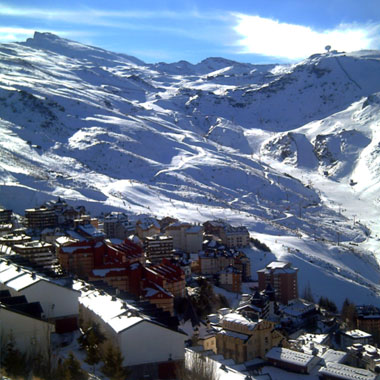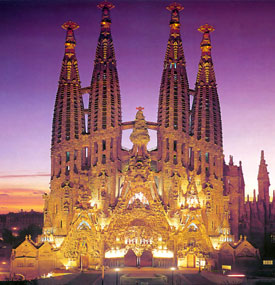Spain
Country statistics

Land area: 192,873 sq miles (499,542 sq km)
Total area: 194,897 sq miles (504,782 sq km)
Population (2010 est.): 40,548,753 (growth rate: 0.0%); birth rate: 9.5/1000; infant mortality rate: 4.1/1000; life expectancy: 80.2; density per sq miles: 210
Capital City: Madrid
Monetary unit: Euro (formerly peseta)
Languages: Castilian Spanish 74% (official nationwide); Catalan 17%, Galician 7%, Basque 2% (each official regionally)
Ethnicity/race: composite of Mediterranean and Nordic types
Religions: Roman Catholic 94%, other 6%
Country introduction

Spain is located in South-western Europe on the Iberian Peninsula and is bordered to the south and east by the Mediterranean Sea (except for a small land boundary with the British Overseas Territory of Gibraltar, to which Spain lays claim), to the north and north-east by France, Andorra, and the Bay of Biscay, and to the north-west and west by the Atlantic Ocean and Portugal.
Mainland Spain is dominated by high plateaus and mountain ranges such as the Pyrenees or the Sierra Nevada. Running from these heights are several major rivers such as the Tajo, the Ebro, the Duero, the Guadiana and the Guadalquivir. Alluvial plains are found along the coast, the largest of which is that of the Guadalquivir in Andalusia, in the east there are alluvial plains with medium rivers like Segura, Júcar and Turia.
Spain is bound to the east by Mediterranean Sea (containing the Balearic Islands), to the north by the Bay of Biscay and to its west by the Atlantic Ocean, where the Canary Islands off the African coast are found.
The culture

Culture in Spain is very varied and interesting. Spain has a rich linguistic heritage. There are four official languages; Castilian Spanish (the most commonly spoken), Catalan (used in Catalunya and the Balearics), Basque (spoken in the Basque regions of both France and Spain) and, finally, Galician. There are also a number of local dialects such as Valéncian and Andulucian, which is part of the diverse culture of Spain.
Spain is the world's third largest wine producer; with an industry that most experts regard as the fastest improving vinicuhure of recent decades. Rioja is Spain's best loved variety it's a highly distinctive, full bodied wine available in both red and white.
Spain is widely known for Flamenco music and dance, bullfights, fantastic beaches and lots of sunshine.
Attractions & landmarks

The oldest works of architecture in Spain that exist today go back to the megalythical culture, approximately 3000 BC Lots of Roman monuments are conserved too, among the most important being the great aquaeduct of Segovia and the amphitheater of Mérida.
The Spanish Moors created a style of their own that differed in many aspects from their traditional architecture, which may be found in Africa. This style is called Caliphal style. The Christians who lived in Muslim territory were called Mozarabes, and so it is called their particular architectonical style which combines Visigothic construction technics and caliphal style. After the country was reconquered from the Muslims, Moorish architects who stayed developed another new style combining their traditional architecture with Romanesque and Gothic elements, the Mudejar style.
The Great Mosque of Cordoba is one of the most visited sights by tourists, there are also the Moorish towns of Cadiz, Granada, Cordoba, all full of historic buildings such as the Alhambra Palace in Granada, which is perfectly conserved in its original condition. In modern architecture, one of the most outstanding works of Antoni Gaudì in Barcelona, is his great cathedral 'Sagrada Familia'.
Other places to check out include the Santiago de Compostela, a famous pilgrimage town where it is believed the Apostle St. James was buried in the Cathedral. Pamplona can also be visited to take part in the San Fermin festival with it's Running of the Bulls. Also, Burgos city has many historic landmarks, of particular importance; the Cathedral of Burgos, Las Huelgas Reales Monastery and the Cartuja of Miraflores. Of particular note Cartuja de Miraflores has an altarpiece which was gilded with the first gold brought back from South America by Christopher Columbus.